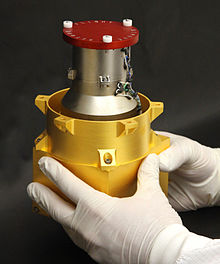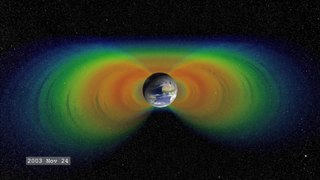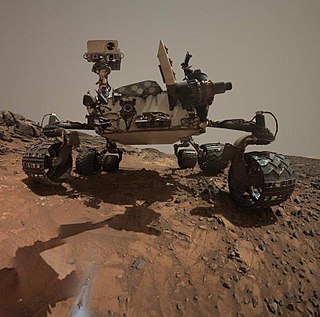

The Radiation Assessment Detector (RAD) is an instrument mounted on the Mars Science Laboratory 's Curiosity rover. It was the first of ten instruments to be turned on during the mission.


The Radiation Assessment Detector (RAD) is an instrument mounted on the Mars Science Laboratory 's Curiosity rover. It was the first of ten instruments to be turned on during the mission.
The first role of RAD was to characterize the broad spectrum of radiation environment found inside the spacecraft during the cruise phase. These measurements have never been done before from the inside of a spacecraft in interplanetary space. Its primary purpose is to determine the viability and shielding needs for potential human travelers on a human mission to Mars, as well as to characterize the radiation environment on the surface of Mars, which it started doing immediately after MSL landed in August 2012. [1] Turned on after launch, the RAD recorded several radiation spikes caused by the Sun. [2]
RAD is funded by the Exploration Systems Mission Directorate at NASA Headquarters and Germany's Space Agency (DLR), and developed by the Southwest Research Institute (SwRI) and the extraterrestrial physics group at Christian-Albrechts-Universität zu Kiel, Germany. [1] [2]
On 31 May 2013, NASA scientists reported the results obtained during cruise, and stated that the equivalent dose radiation for even the shortest round-trip with current propulsion systems and comparable shielding is found to be 0.66±0.12 sievert . This implies a great health risk caused by energetic particle radiation for any human mission to Mars. [3] [4] [5]
In addition to assessing the radiation environment at Mars, data from RAD can also be used for the study of space weather. The arrival of coronal mass ejections at Mars can be detected in RAD data through the Forbush decreases that their passage causes in the Galactic cosmic radiation. These measurements have led to the finding that fast CMEs can continue to decelerate even beyond Earth orbit when dragged by slower surrounding solar wind. [6]
In September 2017, NASA reported radiation levels on the surface of Mars were temporarily doubled, and were associated with an aurora 25-times brighter than any observed earlier, due to a massive, and unexpected, Solar particle event and associated solar storm in the middle of the month. [7]
The radiation sources that are of concern for human health also affect microbial survival as well as the preservation of organic chemicals and biomolecules. [8] The RAD is currently quantifying the flux of biologically hazardous radiation at the surface of Mars today, and will help determine how these fluxes vary on diurnal, seasonal, solar cycle and episodic (flare, storm) timescales. These measurements will allow calculations of the depth in rock or soil to which this flux, when integrated over long timescales, provides a lethal dose for known terrestrial microorganisms. Through such measurements, scientists can learn how deep below the surface life would have to be, or have been in the past, to be protected. [9]
Research published in January 2014 of data from RAD, state that "ionizing radiation strongly influences chemical compositions and structures, especially for water, salts, and redox-sensitive components such as organic matter." [10] The report concludes that the in situ "surface measurements —and subsurface estimates— constrain the preservation window for Martian organic matter following exhumation and exposure to ionizing radiation in the top few meters of the Martian surface. [10]

2001 Mars Odyssey is a robotic spacecraft orbiting the planet Mars. The project was developed by NASA, and contracted out to Lockheed Martin, with an expected cost for the entire mission of US$297 million. Its mission is to use spectrometers and a thermal imager to detect evidence of past or present water and ice, as well as study the planet's geology and radiation environment. It is hoped that the data Odyssey obtains will help answer the question of whether life existed on Mars and create a risk-assessment of the radiation that future astronauts on Mars might experience. It also acts as a relay for communications between the Curiosity rover, and previously the Mars Exploration Rovers and Phoenix lander, to Earth. The mission was named as a tribute to Arthur C. Clarke, evoking the name of his and Stanley Kubrick's 1968 film 2001: A Space Odyssey.

Cosmic rays are high-energy particles or clusters of particles that move through space at nearly the speed of light. They originate from the Sun, from outside of the Solar System in our own galaxy, and from distant galaxies. Upon impact with Earth's atmosphere, cosmic rays produce showers of secondary particles, some of which reach the surface, although the bulk is deflected off into space by the magnetosphere or the heliosphere.

A Van Allen radiation belt is a zone of energetic charged particles, most of which originate from the solar wind, that are captured by and held around a planet by that planet's magnetosphere. Earth has two such belts, and sometimes others may be temporarily created. The belts are named after James Van Allen, who is credited with their discovery.

Mars Science Laboratory (MSL) is a robotic space probe mission to Mars launched by NASA on November 26, 2011, which successfully landed Curiosity, a Mars rover, in Gale Crater on August 6, 2012. The overall objectives include investigating Mars' habitability, studying its climate and geology, and collecting data for a human mission to Mars. The rover carries a variety of scientific instruments designed by an international team.

The possibility of life on Mars is a subject of interest in astrobiology due to the planet's proximity and similarities to Earth. To date, no proof of past or present life has been found on Mars. Cumulative evidence suggests that during the ancient Noachian time period, the surface environment of Mars had liquid water and may have been habitable for microorganisms, but habitable conditions do not necessarily indicate life.

The Martian Radiation Experiment, or MARIE was designed to measure the radiation environment of Mars using an energetic particle spectrometer as part of the science mission of the 2001 Mars Odyssey spacecraft. It was led by NASA's Johnson Space Center and the science investigation was designed to characterize aspects of the radiation environment both on the way to Mars and while it was in the Martian orbit.

Colonization or settlement of Mars is the theoretical human migration and long-term human establishment of Mars. The prospect has garnered interest from public space agencies and private corporations and has been extensively explored in science fiction writing, film, and art.
A Forbush decrease is a rapid decrease in the observed galactic cosmic ray intensity following a coronal mass ejection (CME). It occurs due to the magnetic field of the plasma solar wind sweeping some of the galactic cosmic rays away from Earth. The term Forbush decrease was named after the American physicist Scott E. Forbush, who studied cosmic rays in the 1930s and 1940s.

The idea of sending humans to Mars has been the subject of aerospace engineering and scientific studies since the late 1940s as part of the broader exploration of Mars. Long-term proposals have included sending settlers and terraforming the planet. Proposals for human missions to Mars have come from agencies such as NASA, CNSA, the European Space Agency, Boeing, and SpaceX. As of 2023, only robotic landers and rovers have been on Mars. The farthest humans have been beyond Earth is the Moon, under the Apollo program.
Health threats from cosmic rays are the dangers posed by cosmic rays to astronauts on interplanetary missions or any missions that venture through the Van-Allen Belts or outside the Earth's magnetosphere. They are one of the greatest barriers standing in the way of plans for interplanetary travel by crewed spacecraft, but space radiation health risks also occur for missions in low Earth orbit such as the International Space Station (ISS).

EXPOSE is a multi-user facility mounted outside the International Space Station (ISS) dedicated to astrobiology. EXPOSE was developed by the European Space Agency (ESA) for long-term spaceflights and was designed to allow exposure of chemical and biological samples to outer space while recording data during exposure.

Recognized effects of higher acute radiation doses are described in more detail in the article on radiation poisoning. Although the International System of Units (SI) defines the sievert (Sv) as the unit of radiation dose equivalent, chronic radiation levels and standards are still often given in units of millirems (mrem), where 1 mrem equals 1/1,000 of a rem and 1 rem equals 0.01 Sv. Light radiation sickness begins at about 50–100 rad.
Interplanetary contamination refers to biological contamination of a planetary body by a space probe or spacecraft, either deliberate or unintentional.

Astronauts are exposed to approximately 50-2,000 millisieverts (mSv) while on six-month-duration missions to the International Space Station (ISS), the Moon and beyond. The risk of cancer caused by ionizing radiation is well documented at radiation doses beginning at 100mSv and above.

Curiosity is a car-sized Mars rover exploring Gale crater and Mount Sharp on Mars as part of NASA's Mars Science Laboratory (MSL) mission. Curiosity was launched from Cape Canaveral (CCAFS) on November 26, 2011, at 15:02:00 UTC and landed on Aeolis Palus inside Gale crater on Mars on August 6, 2012, 05:17:57 UTC. The Bradbury Landing site was less than 2.4 km (1.5 mi) from the center of the rover's touchdown target after a 560 million km (350 million mi) journey.

The Mars Science Laboratory and its rover, Curiosity, were launched from Earth on November 26, 2011. As of September 25, 2023, Curiosity has been on the planet Mars for 3959 sols since landing on August 6, 2012. (See Current status.)

Icebreaker Life is a Mars lander mission concept proposed to NASA's Discovery Program. The mission involves a stationary lander that would be a near copy of the successful 2008 Phoenix and InSight spacecraft, but would carry an astrobiology scientific payload, including a drill to sample ice-cemented ground in the northern plains to conduct a search for biosignatures of current or past life on Mars.
ExoLance is a low-cost mission concept that could hitch a ride on other missions to Mars in an effort to look for evidence of subsurface life.

A Mars suit or Mars space suit is a space suit for EVAs on the planet Mars. Compared to a suit designed for space-walking in the near vacuum of low Earth orbit, Mars suits have a greater focus on actual walking and a need for abrasion resistance. Mars' surface gravity is 37.8% of Earth's, approximately 2.3 times that of the Moon, so weight is a significant concern, but there are fewer thermal demands compared to open space. At the surface the suits would contend with the atmosphere of Mars, which has a pressure of about 0.6 to 1 kilopascal. On the surface, radiation exposure is a concern, especially solar flare events, which can dramatically increase the amount of radiation over a short time.
ADRON-RM is a neutron spectrometer to search for subsurface water ice and hydrated minerals. This analyser is part of the science payload on board the European Space Agency'sRosalind Franklin rover, tasked to search for biosignatures and biomarkers on Mars. The rover is planned to be launched in August–October 2022 and land on Mars in spring 2023.